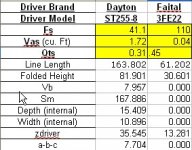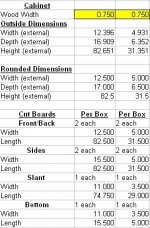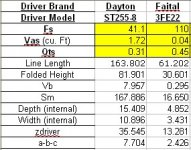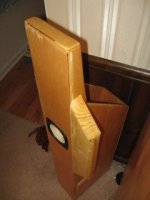This angling out would probably negate the effect of final expansion the corners (or ceiling-wall at least) have for the design, turning it into a kind of "hidden transmission line" enclosure. Not bad, per se, but probably without the bass extension that is characteristic of the design.
Gaston
If you put the vent at the very top corner between the wall and ceiling you may still end up with pretty good ceiling loading and corner loading. The smaller net Vb can be dealt with using smaller drivers with lower Qts. If the BIB has a 50 square in or less cross sectional area, it can work.
If you put the vent at the very top corner between the wall and ceiling you may still end up with pretty good ceiling loading and corner loading. The smaller net Vb can be dealt with using smaller drivers with lower Qts. If the BIB has a 50 square in or less cross sectional area, it can work.
Yes, that´s right but except if one has a room of almost exact proportions, or non-beaming speakers (*very* rare at HF) it will involve mounting the speaker at an angle to fire adequately at the listening position and that will be fixed too. IMO, it's very complex and has too many constraints to be attractive. But... there are horses for courses, and it might fit some people.
In-wall mounting is more attractive to me in the case of really big sub-woofer tapped horns.
Gaston
I've been trying to find a BIB calculator that works with apple. Is there a version that works with apple?
I want to build FIB for faital pro 3fe22, will be wallmount in a small appartment.
They work great in tabaqs so my hopes are high for FIBs on wall!
Pepe
I want to build FIB for faital pro 3fe22, will be wallmount in a small appartment.
They work great in tabaqs so my hopes are high for FIBs on wall!
Pepe
Pepe,
I ran the driver on my copy of the calculator, Here are the results:
Ignore the Dayton result in the first column. The results you want are in the second column all the way to the right.
Hope this will help.
John
Edit: the first pic has no values, I don't know why... I added another screen shot of the right info, but don't know how to delete the first pic....
The corrected picture didn't up load, let me try again....
I ran the driver on my copy of the calculator, Here are the results:
Ignore the Dayton result in the first column. The results you want are in the second column all the way to the right.
Hope this will help.
John
Edit: the first pic has no values, I don't know why... I added another screen shot of the right info, but don't know how to delete the first pic....
The corrected picture didn't up load, let me try again....
Attachments
Last edited:
I've been trying to find a BIB calculator that works with apple. Is there a version that works with apple?
I want to build FIB for faital pro 3fe22, will be wallmount in a small appartment.
They work great in tabaqs so my hopes are high for FIBs on wall!
Pepe
Hi Pepe
As far as I know, the BIB calculator should work fine with Libre Office (free, open source office suite), which is available for every (well... almost) operating system.
Libre Office Download page
The calculator makes use of only a few formulas so it should be no problem to you to use.
Gaston
John,
Thank you for the info.
Will have to read up a little on how to determind how to determind the exact messires of the cabs and sorce some good build material, some wood that is light but/and stiff.
Thank you for the info.
Will have to read up a little on how to determind how to determind the exact messires of the cabs and sorce some good build material, some wood that is light but/and stiff.
Hi Gaston. I will try that, thank you for pointing that out to me (i'm a new user of mac).
You don't happen to know where to sorce build material in Bs As, some where that they cut the pieces for you?
Pepe
You don't happen to know where to sorce build material in Bs As, some where that they cut the pieces for you?
Pepe
You don't happen to know where to sorce build material in Bs As, some where that they cut the pieces for you?
Pepe
Mnope... I did the job myself with barely acceptable ply bought from Home Depot (before they were bought by Easy) and also used scrape particleboard from a donor furniture piece.
If you are in Buenos Aires, then La Viruta can do that for you (and it is somewhat expensive) but also almost any wood shop will do the cutting with the right tolerances if you explain they clearly that you want the wood to make a piece of furniture with close tolerances. You want your squares square 🙂
Not in Bs As yet, qill be there in a few days. Will contact La Viruta when I get there.
In sweden we have sucha strong/big diy carpenter/construction culture that we are really spoiled with tons of good places to buy good quality ply, mdf, etc. Not so much in Argentina it seems.
Would love to score some quebracha plywood!
In sweden we have sucha strong/big diy carpenter/construction culture that we are really spoiled with tons of good places to buy good quality ply, mdf, etc. Not so much in Argentina it seems.
Would love to score some quebracha plywood!
You can download the BIB Calculator from this link:
https://sites.google.com/site/speakerprojects/enclosures/bib
Zilla
https://sites.google.com/site/speakerprojects/enclosures/bib
Zilla
BIB calculator
Or you can get the BIB calculator at:
http://www.diyaudio.com/forums/full-range/233720-just-found-bib-design.html
then scroll down to post #9
Roger
You can download the BIB Calculator from this link:
https://sites.google.com/site/speakerprojects/enclosures/bib
Zilla
Or you can get the BIB calculator at:
http://www.diyaudio.com/forums/full-range/233720-just-found-bib-design.html
then scroll down to post #9
Roger
Terminated BIB?
The BIBs that I have made are generally smaller with 3" drivers. Earlier in this thread, it was mentioned that because of the small size, the cabinets should be down firing with the open end on the bottom.
For those particular speakers, setting them off the floor on milk crates was a good solution.
My question is: How could this elevation be incorporated into the plans?
A) Raise them up on legs?
B) Terminate the cabinet with a large mouth at the bottom?
C) Terminate with open front and back at the bottom?
Here is plans for B with a 10.5" X 7.75" X 5" mouth at the bottom. How do you calculate the height off of the floor? (10.5 was just a guess)
JohnH
The BIBs that I have made are generally smaller with 3" drivers. Earlier in this thread, it was mentioned that because of the small size, the cabinets should be down firing with the open end on the bottom.
For those particular speakers, setting them off the floor on milk crates was a good solution.
My question is: How could this elevation be incorporated into the plans?
A) Raise them up on legs?
B) Terminate the cabinet with a large mouth at the bottom?
C) Terminate with open front and back at the bottom?
Here is plans for B with a 10.5" X 7.75" X 5" mouth at the bottom. How do you calculate the height off of the floor? (10.5 was just a guess)
JohnH
Attachments
Last edited:
D) Unfold it. Then it will be tall enough for the ceiling unless you have unusually tall ceilings.
D) Unfold it. Then it will be tall enough for the ceiling unless you have unusually tall ceilings.
One of the main ideas in the BiB is vertical excitation of the room. So a sideways mouth would be against the spirit.
Well, simply unfolding it would place the diver at only 16" from floor, certainly a full 12" too low, I think - then there's the aesthetics of stabilizing the enclosure.
Raising the downward facing terminus too far above the floor could reduce gain effected by the boundary loading.
The only such design that I've heard (i.e. BIB with downfiring terminus and small driver) had side (& I think back) panels extended to raise the driver to approx 30", and resulted in rather an inordinate amount of coloration.
Raising the downward facing terminus too far above the floor could reduce gain effected by the boundary loading.
The only such design that I've heard (i.e. BIB with downfiring terminus and small driver) had side (& I think back) panels extended to raise the driver to approx 30", and resulted in rather an inordinate amount of coloration.
Last edited:
Well, simply unfolding it would place the diver at only 16" from floor! certainly a full 12" too low, then there's the aesthetics of stabilizing the enclosure.
Raising the downward facing terminus too far above the floor could reduce gain effected by the boundary loading.
The only such design that I've heard (i.e. BIB with downfiring terminus and small driver) had side & I think back) panels extended to raise the driver to approx 30", and resulted in rather an inordinate amount of coloration.
Raising the downward facing terminus too far above the floor could reduce gain effected by the boundary loading.
The only such design that I've heard (i.e. BIB with downfiring terminus and small driver) had side & I think back) panels extended to raise the driver to approx 30", and resulted in rather an inordinate amount of coloration.
Well, either put it on the wall or a simple stand. A real simple idea would be to simply let the side boards continue down until the desired hight was achieved, not cut them off to triangles to fit the horn.
Last edited:
In a similar vein, I auditioned this little one and it was pretty anemic until placed on a large, relatively massive 'L' shaped work desk, tucked hard up against a corner. With them on each outside corner, this brought the drivers up to a good height and with the terminus loaded in a quasi-quarter space [1 pi] they proved to have a nice robust [mid]bass line that needed no BSC with the added baffle width.
GM
GM
Attachments
FIB anyone?
Flatten the BIB to the point that you can mount it on a wall. Divide the area into two asymmetric sections with an inverted V and this allows offset mounting for reduced baffle diffraction effects. Mounting on a wall does not require BSC.
http://www.diyaudio.com/forums/full-range/66173-terry-cains-bib-why-does-work-does-anyone-have-those-fostex-craft-handbooks-514.html#post3342958
Or follow more standard single divider BIB but Flatter is Better (FIB):
http://www.diyaudio.com/forums/attachments/full-range/326011d1359011895-foam-core-board-speaker-enclosures-fib-plan.jpg
Note that plan should be 3 in deep not 4.
Flatten the BIB to the point that you can mount it on a wall. Divide the area into two asymmetric sections with an inverted V and this allows offset mounting for reduced baffle diffraction effects. Mounting on a wall does not require BSC.
http://www.diyaudio.com/forums/full-range/66173-terry-cains-bib-why-does-work-does-anyone-have-those-fostex-craft-handbooks-514.html#post3342958
Or follow more standard single divider BIB but Flatter is Better (FIB):
http://www.diyaudio.com/forums/attachments/full-range/326011d1359011895-foam-core-board-speaker-enclosures-fib-plan.jpg
Note that plan should be 3 in deep not 4.
Last edited:
My question is: How could this elevation be incorporated into the plans?
A) Raise them up on legs?
B) Terminate the cabinet with a large mouth at the bottom?
C) Terminate with open front and back at the bottom?
A) Yes, with the assumption that they will be hard up against a wall and preferably in a corner in which case the gap would be the same as with ceiling loaded, i.e. > ~75% of ceiling height.
This assumes a low tuned BIB though, so with no actual experience with the BIB per se [my pipe horns were all mass loaded], I’m inclined to take the small BIB’s folded height/3 to maintain the same percentage gap and adjust from there if need be, so working out the pipe tuning would be a function of driver/floor height rather than Fs.
B) A front firing terminus loses much of its loading if spaced up, so better overall to make the pipe longer to space it up even if you don’t continue the expansion, i.e., adding in effect a ducted vent with a CSA = the terminus CSA. That, or design to a lower pipe tuning [Fp] as I noted somewhere in this thread.
C) Any configuration can be used when it has the right amount of open area to perform as well as can be expected, including horn designer Bruce Edgar’s mass loading pyramid ‘phase plug’ used in his large vertical bass horn and my personal choice from both theory and experience.
GM
- Home
- Loudspeakers
- Full Range
- Terry Cain's BIB -why does it work and does anyone have those Fostex Craft Handbooks?



